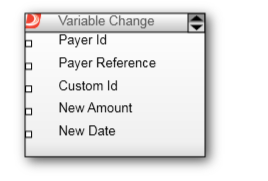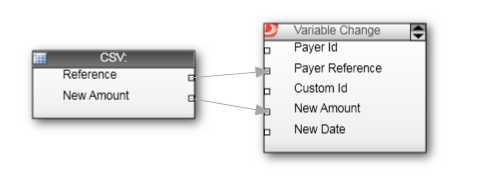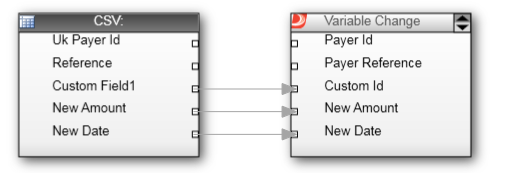You can automate the updating of variable payer data using a PayGate Workflow and mapping.
Use the Variable Update Connector

Updating the Collection Date
You can update the collection date of the next scheduled collection by supplying a date (in DD/MM/YYYY format) to the 'New Date' input of the Variable Change connector.
PayGate uses the follow rules when updating collection dates:
Updating the Collection Amount
You can update the collection amount of the next scheduled collection by supplying a new amount as a standard decimal number (no currency symbol) to the 'New Amount' input of the Variable Change connector.
Linking your variable data to a PayGate Payer.
PayGate needs some way to link the variable data to an actual Payer record. You can do this in several ways by including a reference field in with you imported data. You can use one of the following references:
You should only use one reference field. If more than one is present PayGate will use the fields in the following priority: Payer Id, Payer Reference, Custom Id.
Variable Updates - Example #1.
In this example a utility company, PowerCom, bills it's customer monthly with a variable amount. PayGate Enterprise DDMS is used to manage the Direct Debit process and a separate finance system determines the variable collection amount. Payer pay their bill on the same day each month.
In this scenario the date is fixed and so we do not need to provide any new payment date information. The amount, however, is variable and we must let PayGate to update the payer's next collection date to a new value.
PowerCom use their finance system to create a simple file in CSV format that contains the Payer's reference and the new payment amount.
Contents of the CSV file:
The csv file contains two fields: the Payer Reference 'Reference' and the new collection amount 'New Amount'. It could, of course, contain many other fields - these would simply be ignored by PayGate.
The csv file also contains a column header and looks like the following.
Reference,New Amount 0001T/F Surname1 ,9.99 0001S/F Surname0 ,8.88 |
The following mapping will work for this scenario because it connects the Payer reference field in the CSV file to the 'Payer Reference' field of the 'Variable Change' connector. This allows PayGate to match the incoming data with a payer record stored in PayGate.

The 'New Date' field will be ignored because there is no incoming data to the 'New Date' connector.
Variable Updates - Example #2.
In this example we consider a scenario were you cannot output your variable data with either the PayGate PayerId or Reference. You have your own unique reference number and wish to use that instead.
The PayGate Mapping needs to match the incoming date or amount change with a payer record stored in PayGate - there needs to be a common 'key' in both data sets. We will solve this problem and provide a common key by adding your own reference id into PayGate using one of the custom fields available in the payer record. The custom fields can be set using the PayGate Client in the Edit Payer page. Expand the 'Custom Fields' section to reveal the custom fields.

The 'Custom Id' input in the Variable Change mapping connector maps directly to the value of 'Custom Field 1'.

Note that is this example both the New Amount and new Date field are mapped. In this mapping bother fields will be updated with a single mapping.